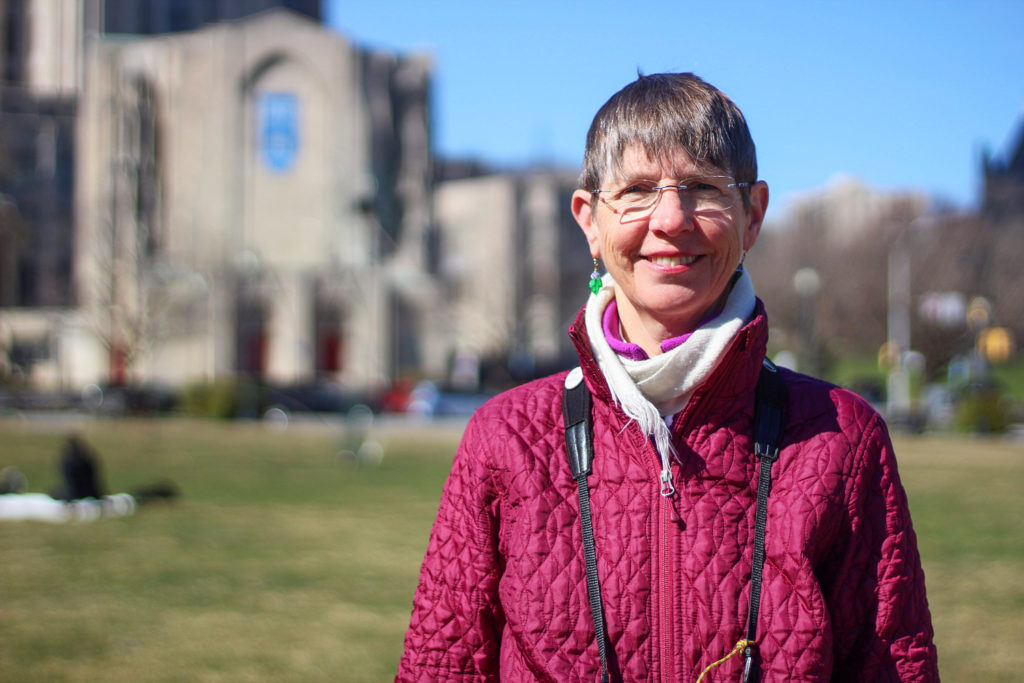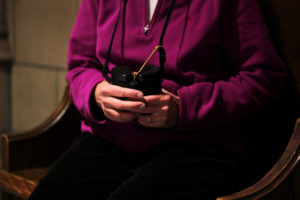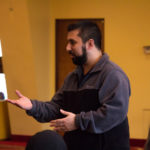Keep Looking Up

words: Nicole Slater
photos: Lauren Zawatski
On some days, when you look up at the Cathedral of Learning, you might catch a glimpse of peregrine falcons taking flight.
That is not the case on this brisk October day, but it doesn’t stop birder Kate St. John from pulling out her binoculars to look to the sky.
St. John’s family moved to the South Hills of Pittsburgh when she was six. She has lived in the region ever since. Over that time she has worked at many jobs and volunteered at many organizations in Pittsburgh.
However, her favorite thing to do is watch birds.
Her love for birds began when she was in elementary school. “I loved birds because they fly,” St. John explains. Her interest faded away for almost two decades as she built a career working with computers.
In her 30s, though, she once again became involved in the outdoors. It was the peregrines that grabbed her interest.
The peregrine breed of falcon nearly went extinct in the 1960s, but was reintroduced to the United States in the 1980s. The first pair came to Pittsburgh in 1990. They arrived alone, but soon began mating. Western Pennsylvania was not a traditional nesting area for peregrines in the past because there are few sheer rock cliffs and many foxes. But, the birds have found a home here. And the human inhabitants of Western Pennsylvania have found themselves intrigued.
“They are so charismatic. They’re gorgeous. They’re fearless,” St. John explains. “They would do reckless things, things that you’d think, ‘You’re going to die,’ but they usually don’t. They attack birds much larger than them and they win.”

St. John can often be seen in Oakland, binoculars in hand, looking to the sky for peregrines.
The peregrine falcon is a solitary animal and not friendly to human intruders. As the main volunteer monitor for the Cathedral’s peregrine falcons, St. John has spent many hours watching the birds and how they interact with each other. She serves as the point person on all things peregrine, remaining in close contact with the Pennsylvania Game Commission. Her knowledge of the history of the birds is apparent in her ability to spout off facts and important dates like she’s reading out of a book.
St. John’s favorite part of watching the peregrines is “Fledge Watch,” which is the time she and her fellow birdwatchers spend waiting for the baby peregrines to take their first flight off of the Cathedral.
During one such watch, the father bird, named Erie, flew around trying to persuade his babies to take the leap.
“He would fly and they’d all flap their wings, like, ‘oh boy, oh boy!’” St. John recounts excitedly. “At one point he flew away from them, level, same height as them and then he flipped upside down and flew straight at them. And they were going nuts! It was way cool.”
St. John’s enthusiasm for the falcons has gotten others hooked.
“As the population of peregrines has increased, there have been people that follow them at different locations,” she says.
These locations include tall buildings in Downtown Pittsburgh and the George D. Stuart Bridge in Tarentum.
These days, St. John spends much of her time maintaining her popular blog, “Birds Outside My Window.” She is surprised by the amount of people who read her daily posts, but more so by the articles that attract readers.
“There are days I work really hard on a subject and I do all the research and three people like it,” she says. “There are things I don’t even try on at all and they get fifty likes in an hour.”
Contributing photographer Steve Gosser continues to send photographs to the blog because he wants to help St. John gain awareness for the issues she writes about.
“By reading her blog, you can easily tell she loves to understand as much as she can about birds and nature and the reasons why everything is as it is,” Gosser says.
However, St. John noticed that she gets the most views following a tragedy, like the death of Dorothy, a peregrine falcon, early in 2016.
With resources like St. John’s blog and the Nest Cam on the Aviary website, people can feel like they are familiar with the falcons by watching them interact in their habitat. But St. John warns that people must not forget that these are wild animals that do not act in the same way we do.
“There are some surprises. When you watch nature you have to not to jump to a conclusion about what’s going on,” she explains. “I do it myself all the time, ‘I think they must be doing that because…’ but the answer is no. Everything we see is purposeful.”
Learning about birds and other animals, St. John says, is an important part of our continuing success as a civilization.
“We are animals. We are not that different from other animals. Some of the stuff they do better than we do,” she says.
St. John believes being outdoors is vital to the happiness of human beings.
“Being outdoors makes people happier,” she says. “They don’t realize taking a walk outside calms you down. There’s something about the way we live today that makes us lose connection with what’s good for us.”
The importance of watching and learning from nature and its inhabitants is something St. John feels strongly about.
“All the things we’ve invented that we live with today are quite recent,” she says. “The Industrial Revolution is only a couple hundred years old. Agriculture is only 10,000 years old. Birds have been here since the dinosaurs. There are things that are more used to living on earth and we could stand to learn from.”
While St. John has an appreciation of the technology that surrounds us on a daily basis, she wonders what would happen to us if one day all of our gadgets went away.
“Keep looking up,” she says. “Being outside takes you out of yourself, which is a good thing. We get all worried about stuff, and then you look up and there’s a peregrine!”
 Previous Post
Previous Post Next Post
Next Post